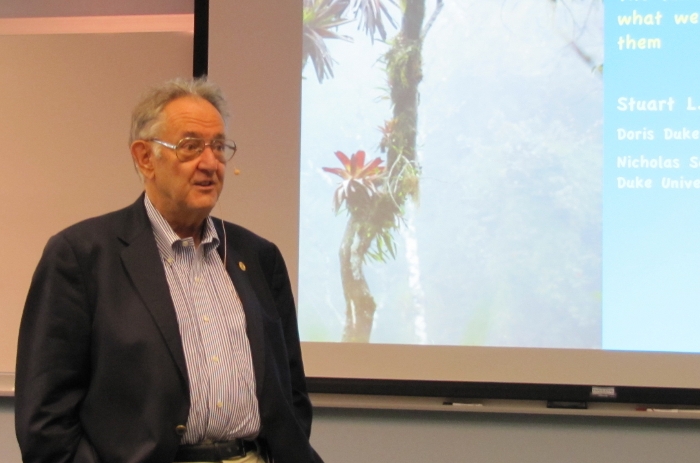NIMBioS Seminar Series
In conjunction with the interdisciplinary activities of the National Institute for Mathematical and Biological Synthesis (NIMBioS), a seminar series on topics in mathematical biology will be hosted at NIMBioS every other Tuesday at 3:30 p.m. (unless otherwise noted) in the Hallam Auditorium, Room 206, Claxton Building, 1122 Volunteer Blvd. Seminar speakers will focus on their research initiatives at the interface of mathematics and many areas of the life sciences. Light refreshments will be served in Room 205 beginning 30 minutes before each talk. Faculty and students from across the UT community are welcome to join us.
Time/Date: Monday, September 28, 2015, 3:30 p.m.*
Location:
Room 206, Claxton Building, 1122 Volunteer Blvd.
Speaker:
Dr. Stuart Pimm, Doris Duke Professor of Conservation, Nicholas School of the Environment, Duke Univ.
Topic:
The laws of biodiversity and what we do not understand about them
Abstract:
The practice of conservation biodiversity starts with understanding which species and which places are priorities in preventing species decline and extinction. A minority are obvious and familiar: large bodied vertebrates, especially predators, are hunted or persecuted over their large geographical ranges. The large majority of threatened vertebrates have small geographical ranges leading them to be vulnerable to habitat destruction. Armed with where these species live, we can make strategic choices of which places are world priorities – the "biodiversity hotspots" – and downscale to tactical decisions on exactly where and how to protect them.
There's an obvious problem. We are protecting biodiversity based on 0.1% of species. Taxonomists are not going to name, let alone map, the remaining 99.9% anytime soon. This motivates a search for general patterns of biodiversity – I call them "laws" – and an understanding of them that might help address whether they are likely to apply equally to known and unknown taxa.
Wallace promulgated the most famous law of biodiversity: "Every species has come into existence coincident both in space and time with a pre-existing closely allied species." A simple enough pair of observations, yet ones with profound implications. There are others. The sizes of species ranges have consistent log-normal distributions. Widespread species are locally common, whereas local species are generally rare. Species densities vary greatly from place to place. Species with small geographical ranges are geographically concentrated and generally not in the places where the largest numbers of species live. There is the familiar species-area relationship and there is a distinctive pattern of species loss where habitats are destroyed. To be credible, the theories to explain these laws need to be mechanistically credible, testable against new data, and make hitherto unexpected predictions. Most theories fail these criteria, suggesting considerable effort is needed to understand biodiversity patterns.
*Join us for refreshments at 3 p.m.
Seminar Flyer (pdf)
For more information about this seminar, contact Sergey Gavrilets at gavrila@utk.edu.
![]() Watch seminar online. This video was streamed live. Live-streamed seminars are archived for later viewing on
NIMBioS' YouTube channel.
Watch seminar online. This video was streamed live. Live-streamed seminars are archived for later viewing on
NIMBioS' YouTube channel.
For more information about this and other NIMBioS Seminars, visit /seminars.

NIMBioS
1122 Volunteer Blvd., Suite 106
University of Tennessee
Knoxville,
TN 37996-3410
PH: (865) 974-9334
FAX: (865) 974-9461
Contact NIMBioS



